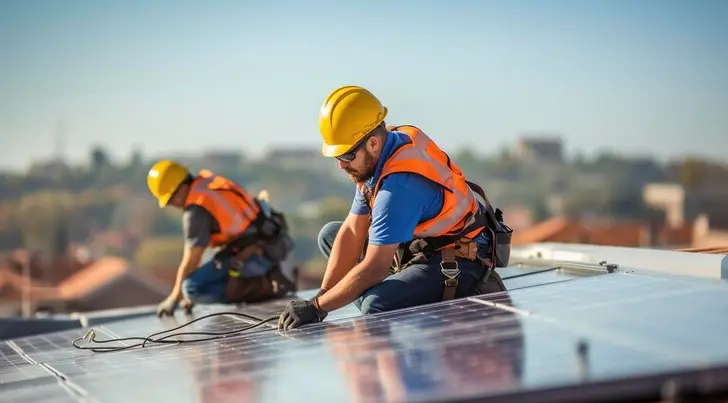
Unveiling the Potential: Calculating the Output of a 6.6 kW Solar System in Sydney
Introduction 6.6 kW Solar Panel System: In the pursuit of a sustainable and eco-friendly future, solar power has emerged as a beacon of hope. This article delves into the world of solar energy and its immense significance in Sydney, Australia. As the quest for energy independence gains momentum, understanding the intricacies of solar power becomes vital.
The Significance of Solar Power

Solar power isn’t just a renewable energy source; it’s a game-changer. With rising concerns about climate change and diminishing fossil fuel reserves, solar energy offers a clean, sustainable solution. Sydney, with its abundant sunlight, is ideally positioned to harness this power and reduce its reliance on conventional energy sources.
The Quest for Energy Independence
Sydney’s growing energy demands necessitate a shift towards energy independence. Relying solely on traditional energy grids can lead to vulnerabilities. Solar power empowers individuals and communities to generate their electricity, reducing their reliance on external sources. It’s a step towards energy self-sufficiency.
Understanding Solar Power Basics
Solar Panels
Solar panels are the heart of any solar system. These panels consist of photovoltaic cells that convert sunlight into electricity. The type of solar panel you choose can significantly impact the efficiency and output of your system.
Photovoltaic Cells
Photovoltaic cells are the building blocks of solar panels. They contain semiconductors that, when exposed to sunlight, generate direct current (DC) electricity. This electricity is then converted into alternating current (AC) power, which is used to power your home.
Solar Panel Types
Solar panels come in various types, including monocrystalline, polycrystalline, and thin-film. Each type has its advantages and disadvantages, affecting factors like cost, efficiency, and space requirements.
Solar Inverters
Solar inverters play a crucial role in the energy conversion process. They convert the DC electricity generated by solar panels into AC power suitable for household use.
Role in Energy Conversion
Inverters ensure that the electricity produced by solar panels is compatible with your appliances and can be fed back into the grid if necessary.
Inverter Variants
There are different types of inverters, such as string inverters, microinverters, and power optimizers. Each has its advantages and is chosen based on specific system requirements.
Sizing Up a 6.6 kW Solar Panel System

System Components
A 6.6 kW solar panel system consists of solar panels and inverters, but it also requires mounting systems to securely install the panels.
Panels and Inverters
Choosing the right panels and inverters is crucial for optimizing system performance. High-quality components can make a significant difference in the long-term output of your 6.6 kW solar panel system.
Mounting Systems
Mounting systems provide the necessary support for solar panels. They need to be installed correctly to ensure the panels are secure and positioned for maximum sunlight exposure.
Factors Influencing System Size
The size of your solar system depends on various factors, including your household’s energy consumption and the availability of roof space.
Household Energy Consumption
Assessing your household’s energy needs is the first step in determining the right system size. Understanding your consumption patterns helps size your system accordingly.
Roof Space Availability
The amount of available roof space also plays a crucial role in system sizing. A larger roof can accommodate more panels, potentially leading to higher energy production.
Solar Energy Generation in Sydney
Sunlight in Sydney
Sydney’s climate offers favorable conditions for solar energy generation. However, it’s essential to understand the seasonal variations and peak sun hours to make the most of your solar system.
Seasonal Variations
Sydney experiences seasonal fluctuations in sunlight. Understanding these variations helps you estimate your system’s output throughout the year.
Peak Sun Hours
Peak sun hours represent the period when sunlight is most intense and productive for solar panels. Sydney enjoys a generous share of these hours, enhancing the efficiency of 6.6 kW solar panel systems.
Solar System Output Factors
Several factors influence the output of your solar system, including efficiency ratings and the tilt and orientation of your panels.
Efficiency Ratings
Solar panels have efficiency ratings that indicate how effectively they convert sunlight into electricity. Higher-rated panels are more efficient but may come at a higher cost.
Tilt and Orientation
The angle and direction at which your panels are installed can impact their performance. Proper alignment ensures optimal sunlight exposure.
Calculating Solar System Output
The 6.6 kW Solar Panel System Output Potential
A 6.6 kW solar panel system has the potential to generate a significant amount of electricity. Understanding this potential helps you gauge its impact on your energy needs.
Energy Production in Daily and Annual Terms
Solar systems produce energy daily, and their annual output can lead to substantial savings on your electricity bills. Monitoring your production is essential to ensure you’re reaping the benefits.
Monitoring Solar Production
Various tools and systems are available to monitor your solar production. Being informed about your system’s performance allows you to identify and address any issues promptly.
Factors Affecting Output
Weather and Climate
Weather and climate have a direct impact on solar production. Cloudy days can reduce output, but there are strategies to mitigate this effect.
Impact on Solar Production
Cloudy days may not produce as much energy as sunny ones, but solar systems can still generate electricity even in overcast conditions.
Dealing with Cloudy Days
Installing larger solar systems or energy storage solutions can help compensate for reduced production during cloudy days.
System Maintenance
Maintaining your solar system is essential to ensure it operates efficiently over the long term.
Cleaning Panels
Dirt, dust, and debris can accumulate on solar panels, reducing their efficiency. Regular cleaning ensures maximum sunlight absorption.
Checking Inverter Performance
Regularly monitoring and maintaining your inverters ensures that they continue to convert electricity effectively.
Maximizing Solar Output
Optimizing Panel Placement
Properly positioning your solar panels is crucial for maximizing output. Consider tilt and angle adjustments and shading considerations.
Tilt and Angle Adjustment
Adjusting the tilt and angle of your panels throughout the year ensures they capture the most sunlight.
Shading Considerations
Shade from nearby trees or buildings can reduce your solar system’s output. Careful placement and shading analysis can mitigate these effects.
Smart Energy Consumption
Shifting your energy usage to coincide with peak sunlight hours and using energy-efficient appliances can help you make the most of your solar power.
Shifting Energy Usage
Running high-energy-consuming appliances during the day when your system is generating the most power can lead to significant savings.
Energy-Efficient Appliances
Investing in energy-efficient appliances further enhances your energy savings and reduces your reliance on the grid.
The Economic Aspect
Return on Investment
While 6.6 kW solar panel systems require an initial investment, the long-term savings and potential for generating income make them financially attractive.
Reducing Energy Bills
Generating your electricity means lower energy bills. Any excess energy can often be sold back to the grid, providing an additional income stream.
Government Incentives
Various government incentives, rebates, and feed-in tariffs can further improve the financial viability of solar systems.
Real-World Case Studies
Case Study 1: Residential Installation
John and Sarah, a couple from Sydney, installed a 6.6 kW solar panel system on their roof. Over the past year, they’ve saved $1,200 on their electricity bills.
Case Study 2: Commercial Installation
A local business, XYZ Manufacturing, invested in a 50 kW solar system. In just two years, they’ve reduced their electricity expenses by 30% and contributed to a greener environment.
Environmental Benefits
Reduced Carbon Footprint
Solar power significantly reduces carbon emissions, helping combat climate change and preserving Sydney’s natural beauty.
Sustainable Energy
Solar power is a sustainable energy source, ensuring that future generations can enjoy the beauty of Sydney and its surroundings.
Debunking Common Myths
Myth 1: Solar Panels Don’t Work in Cloudy Weather
While solar panels perform best in direct sunlight, they can still generate electricity on cloudy days.
Myth 2: Solar Panels Are Too Expensive
The cost of solar panels has decreased significantly in recent years, and various financing options make them accessible to many.
Myth 3: Solar Panels Require Constant Maintenance
Solar panels are low-maintenance, with occasional cleaning and inverter checks being the primary tasks.
Frequently Asked Questions (FAQs)
1. What is the typical lifespan of solar panels?
Solar panels can last 25 years or more with proper maintenance.
2. How long does it take to recoup the initial investment in a solar system?
The payback period for a 6.6 kW solar panel system varies but can be as short as 5-7 years.
3. Are there government incentives for installing solar panels in Sydney?
Yes, there are various incentives and rebates available, depending on your location and system size.
4. Can I install a solar system on a flat roof?
Yes, 6.6 kW solar panel systems can be installed on flat roofs using specialized mounting systems.
5. What happens to excess energy generated by my solar system?
Excess energy can often be sold back to the grid or stored for later use.
The Future of Solar Power in Sydney
As technology advances and environmental awareness grows, the future of 6.6 kW solar panel system in Sydney looks promising. With the potential to reduce energy bills, combat climate change, and foster energy independence, solar power is set to play a pivotal role in shaping Sydney’s energy landscape.
In conclusion, embracing solar power is not just a choice; it’s a necessity. Sydney’s sunny climate and the myriad benefits of solar energy make it an investment worth considering. Whether you’re a homeowner, a business owner, or an environmental enthusiast, solar power has something to offer everyone. It’s time to unlock the full potential of the Sydney sun and take a step towards a brighter, greener future.
Follow us: Facebook, Twitter, Instagram
